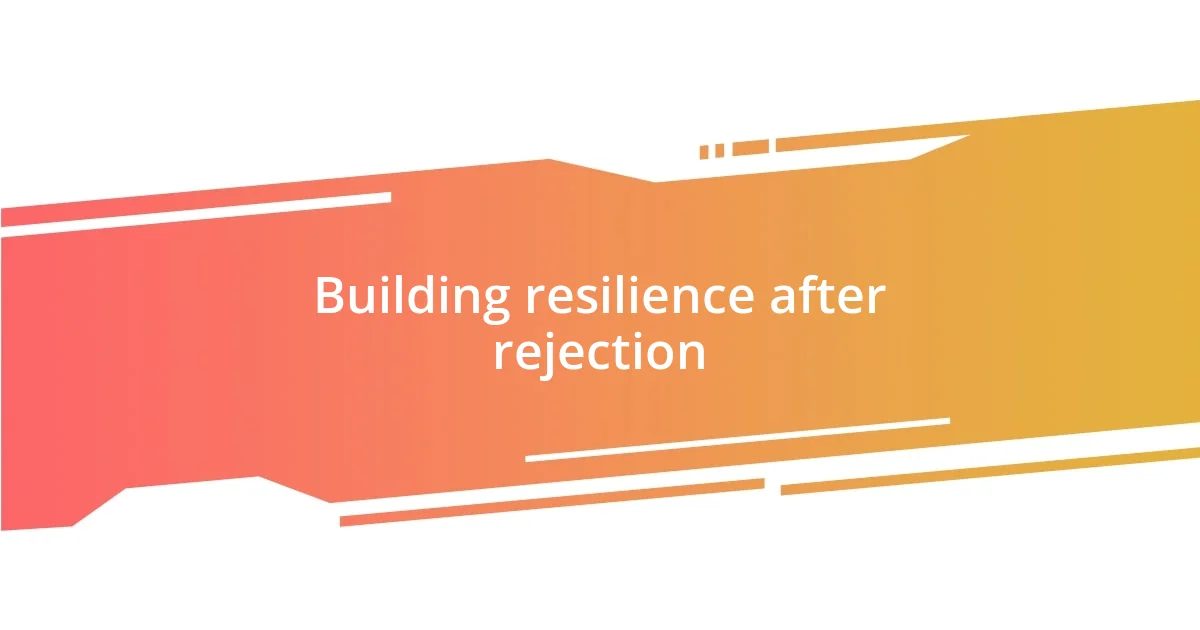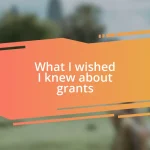Key takeaways:
- Grant rejection can serve as a catalyst for growth; analyzing feedback enables applicants to identify areas of improvement and refine future proposals.
- Common reasons for rejection include misalignment with funder missions, lack of clarity in objectives/methodology, and budget inaccuracies that undermine project feasibility.
- Networking after rejection fosters community and collaboration, providing valuable insights that can reshape future proposals and empower applicants through shared experiences.

Understanding grant rejection outcomes
Understanding the outcomes of grant rejection can be a tough pill to swallow. I remember my first significant grant that I poured my heart into, only to see a “thank you for your application” email arrive instead of the expected approval. It made me wonder—was my idea not good enough, or was it simply a matter of timing and fit?
Often, the reasons for rejection can be multifaceted. In my experience, feedback might focus on limited scope or insufficient evidence supporting my objectives. Sometimes, it felt almost like a puzzle—trying to decipher what the reviewers were looking for, which pushed me to reflect on the clarity and presentation of my proposal.
When faced with rejection, it’s essential not to take it personally but instead to see it as an opportunity for growth. Each rejection has fueled my determination to analyze feedback and strengthen my future submissions. Have you ever felt that initial sting of disappointment turning into motivation? I have, and it reshaped how I approach my work, driving me to refine my ideas and align them better with funders’ expectations.

Analyzing rejection feedback effectively
When I received feedback after a grant rejection, I initially felt disheartened. Yet, I quickly realized that this was a golden opportunity to grow. Analyzing the feedback allowed me to identify patterns and areas of improvement that I had previously overlooked. It’s not just about the comments; it’s about reflecting on them deeply to inform my next steps.
Here’s how I break down the feedback to ensure it’s constructive and actionable:
– Categorize the feedback: Separate comments into themes—content, methodology, budget—so you can analyze where the most significant gaps are.
– Revisit your proposal: Compare it to the feedback systematically. What parts align with the critiques?
– Seek clarity: If a comment lacks clarity, don’t hesitate to reach out to the reviewer if possible. Understanding their perspective can be enlightening.
– Incorporate insights: Use valuable lessons to refine your approach, whether it’s widening the scope or providing more robust evidence.
– Reflect on emotional responses: Acknowledge your feelings but shift your focus to motivation for future applications.
Harnessing feedback is like piecing together a jigsaw puzzle; each piece helps complete a clearer picture of what funders seek.

Common reasons for grant rejections
The most common reasons for grant rejections often boil down to a few key issues. One of the most frequent culprits I noticed in my journey was the misalignment of the proposal with the funder’s mission. I remember being excited about a project, only to find out later that it didn’t match what the granting agency prioritized at that time. It’s like bringing a delectable vegan dish to a barbecue; if the crowd is all about steak, your dish might just get overlooked.
Another common reason lies in the clarity of the proposal itself. If the objectives and methods aren’t clear, reviewers may struggle to see the project’s value. I can still recall a grant application where I was so caught up in my excitement that I glossed over the specifics of the methodology. Feedback pointed this out, and I realized how essential detail is. After all, an unconvincing methodology can raise red flags about the project’s feasibility.
Lastly, budget inaccuracies can lead to immediate rejection. I once had a budget that seemed reasonable to me on the surface, but reviewers flagged it for lacking justification. It hit me hard, but it taught me a vital lesson: a great idea needs a solid financial plan to back it up. Funders need to feel assured that their money will be well spent, and if you can’t show them how, the chances of success dwindle significantly.
| Common Reasons for Grant Rejections | Details |
|---|---|
| Misalignment with Funders | Proposals that don’t align with the funder’s mission are often rejected, even if they have merit. |
| Lack of Clarity | Unclear objectives or methodologies can leave reviewers confused about the project’s value. |
| Budget Issues | Inaccurate or unjustified budgets can lead to immediate rejection, as funders want to ensure proper allocation of resources. |

Strategies to improve future applications
One of the most impactful strategies I discovered is to establish a solid connection with funders early on. I remember attending a networking event where I had the chance to speak directly with a few grant officers. Engaging in casual conversations helped me understand their priorities better than any written guidelines could convey. Have you considered reaching out to funders to ask about their specific interests? Building these relationships can provide crucial insights that guide your proposal development.
Another important tactic is to involve colleagues in the review process before submission. I learned this the hard way when I submitted a proposal without any external eyes on it. A fresh perspective can highlight areas that need clarification or are overly complex. After a peer review of my next application, I felt more confident since others had caught mistakes I initially overlooked. Collaboration not only strengthens your proposal but also fosters community and shared knowledge among peers.
Finally, I found it invaluable to stay updated on successful grant applications in my field. Analyzing winning proposals gave me a clearer picture of what works. I made it a habit to read through examples from grant-winning projects, not just for inspiration but to decode the strategies behind their success. What elements made them stand out? By immersing myself in this analysis, I felt better equipped to address key components like innovation and feasibility, which are vital for capturing funding opportunities.

Building resilience after rejection
When I faced rejection after rejection, I felt like I was stuck in a loop of disappointment. But as I navigated through these difficult emotions, I discovered the importance of reflection. What went wrong? Was it really the project, or perhaps my approach? Analyzing my experiences became a vital part of building my resilience. Every setback turned into a lesson, guiding my next steps rather than defining me.
One significant moment that stands out for me was a rejection I took particularly hard. Instead of sulking, I decided to host a small gathering with colleagues who had faced similar struggles. Sharing our stories created a powerful sense of community. We laughed, we cried, and most importantly, we supported each other. This camaraderie taught me that resilience isn’t just about bouncing back alone; it’s often about leaning on others who understand what you’re going through. It’s comforting to realize that rejection is a shared experience, and together, we can move forward stronger.
Have you ever noticed how rejection can sharpen your focus? I found that after each setback, I became more determined to improve. I set specific goals for myself, such as refining my writing skills and seeking mentorship from seasoned grant writers. This proactive approach transformed my heartbreak into a motivating force. Ultimately, resilience is about taking those painful lessons and using them to fuel your passion. Embracing these challenges made me not just a better applicant but a more grounded individual.

Leveraging rejection for future success
Having faced my fair share of grant rejections, I realized that each “no” can be a stepping stone for future success. One time, I received detailed feedback from a funder who appreciated the innovative aspects of my project but felt it lacked clarity in execution. Instead of brushing it off, I took it seriously and used it to redefine my approach. Have you ever paused to dive into the feedback rather than dismiss it? Embracing constructive criticism can truly transform your proposals and set you on a path toward improvement.
One particular rejection sparked an unexpected shift in my mindset. Feeling discouraged after another “not this time,” I decided to create a comprehensive checklist for future submissions. This included everything from aligning with funder goals to polishing my narrative. By systematically addressing previous shortcomings, I could see not only my progress but also a clear path forward. Have you ever created a tangible plan after feeling lost? It made a profound difference in how I approached my work.
Sometimes, I think about how rejection really fosters innovation. One day, while brainstorming after a particularly tough round of denials, I pivoted my project entirely. Instead of sticking to my original concept, I allowed myself the freedom to explore new ideas. This led me to an unexpected yet compelling angle, ultimately influencing my future applications. How does the idea of starting fresh resonate with you? I learned that leveraging rejection isn’t just about improving—it’s about reshaping our projects into something even more impactful.

Networking after a grant rejection
Networking after a grant rejection became a lifeline for me. After one particularly tough experience, I reached out to fellow researchers who had faced similar challenges. It felt liberating to share not just our disappointments but also our strategies for moving forward. This connection ignited a spark of hope within me; it reminded me that I wasn’t alone in this journey.
Seeking feedback from professionals in my network led to some surprising insights. I recall a coffee chat with a mentor who pointed out the importance of tailoring my proposals to each funder’s values. It made me realize that building relationships isn’t just about gathering contacts; it’s about fostering genuine conversations that can influence our future applications. Have you ever had that one interaction that changed your perspective? I think those moments of clarity are what make networking so valuable.
I also began attending networking events, not just for the sake of connections, but to engage in honest dialogues about grant challenges. By openly discussing our experiences, I discovered new partnerships and collaborations I never thought possible. Isn’t it refreshing to know that even in times of rejection, there’s an opportunity to expand our horizons? Each encounter reinforced that networking is not merely transactional; it’s about forming alliances that uplift us during our lowest moments.















